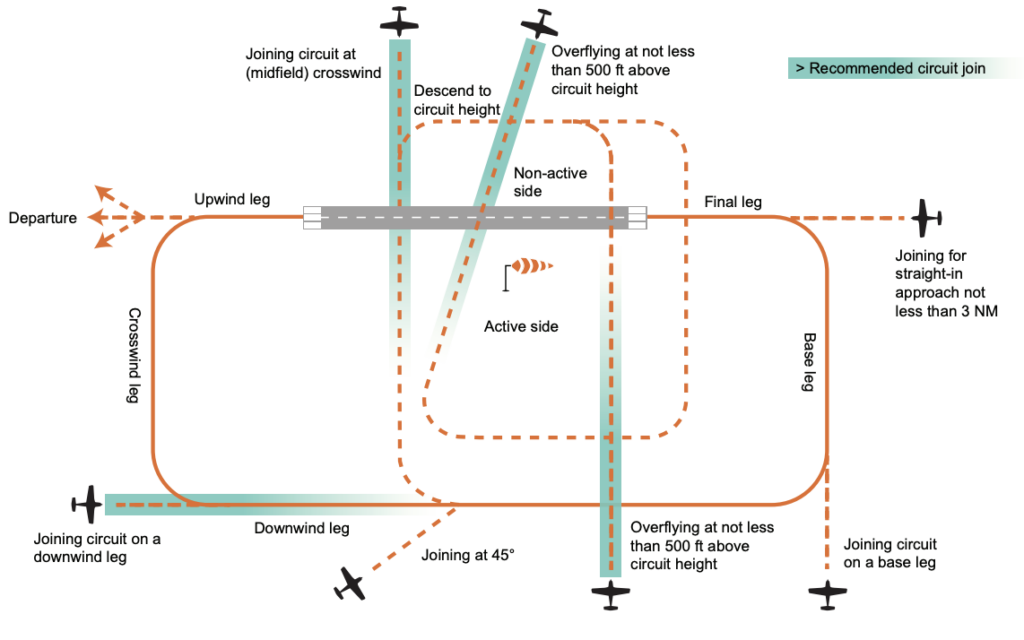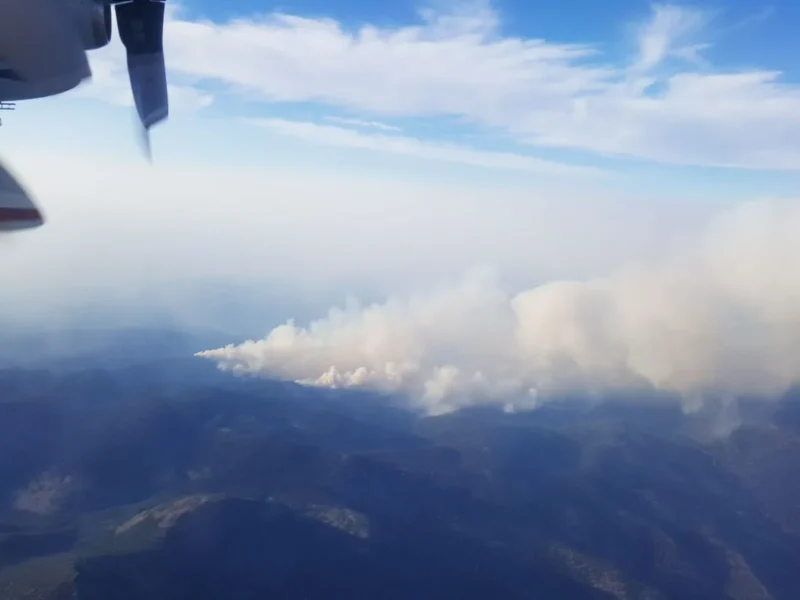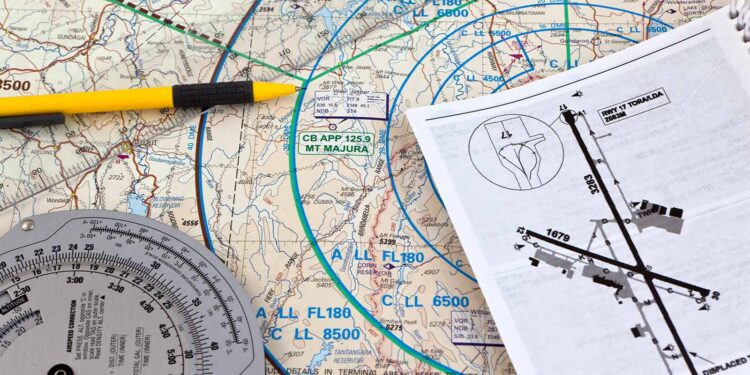Uncontrolled airports are just that. Airports that have no control tower or a tower that is closed. At least in Canada, we have no specific laws that tell you how you should approach an uncontrolled airport to land. Let’s take a look how Canadian Pilots land at an airport with no positive air traffic control.
Note: The scope of this post covers only how to arrive and join the circuit at an uncontrolled aerodrome. There are other procedures like taxiing and departing that aren’t covered here.
ICAO Annex 2, Subchapter 3.2.5
Annex 2 is ICAO’s “Rules of the Air”. These are rules that all pilots flying in ICAO member states should follow. Subchapter 3.2.5 specifically deals with flying at (uncontrolled) airports:
3.2.5 Operation on and in the vicinity of an aerodrome:
a) observe other aerodrome traffic for the purpose of avoiding collision;
b) conform with or avoid the pattern of traffic formed by other aircraft in operation;
c) make all turns to the left, when approaching for a landing and after taking off, unless otherwise instructed;
d) land and take off into the wind unless safety, the runway configuration, or air traffic considerations determine that a different direction is preferable.
That’s it! ICAO leaves it up to each country to decide how aircraft should approach an airport for the purposes of landing.
Canadian Aviation Regulations
The Canadian Aviation Regulations (CARs) are the laws that define how to operate aircraft in Canadian airspace.
Section 602.96(3) of the CARs essentially enact ICAO Annex 2, Subchapter 3.2.5 into Canadian law. In other words, if you break the rules outlined in Annex 2, you are breaking the law in Canada and can be fined/punished under CAR 602.96. However, the CARs have additional laws as to how you should operate in and near an aerodrome:
602.96(4) Unless otherwise authorized by the appropriate air traffic control unit, no pilot-in-command shall operate an aircraft at an altitude of less than 2,000 feet over an aerodrome except for the purpose of landing or taking off or if the aircraft is operated pursuant to subsection (5)
602.97(1) Subject to subsection (3), no pilot-in-command shall operate a VFR or IFR aircraft within an MF area unless the aircraft is equipped with radiocommunication equipment pursuant to Subpart 5.
[…]
602.97(3) The pilot-in-command of a VFR aircraft that is not equipped with the radiocommunication equipment referred to in subsection (1) may operate the aircraft to or from an uncontrolled aerodrome that lies within an MF area if […]
There are no other laws in the CARs that specify how you should approach an uncontrolled airport for the purposes of landing.
Transport Canada even acknowledges this in the Aeronautical Information Manual (AIM):
RAC 4.5.2: The ICAO SARPs do not prescribe, nor does Transport Canada regulate, circuit entry. Furthermore, neither the ICAO SARPs nor the CARs address operating altitudes or the dimensions of the traffic circuit.
What You Can Do Versus What We Expect
Part of the reason why flying is safe is because all pilots adhere to the same rules, laws, and suggestions. Just because you can fly some cowboy traffic circuit into an uncontrolled airport, doesn’t mean you should.
As pilots we all expect everyone to follow the suggested circuit entry procedures as outlined in the AIM. This makes flying predictable and safer for everyone. That said, the information found in the AIM can be confusing at times. This is my attempt at making this information easier to read and understand. At no time am I suggesting any particular circuit entry procedure. As the pilot in command you have a duty to fly the safest entry procedure possible (CAR 602.96(2)).
Three “Modes” Of Uncontrolled Aerodromes
There are three “modes” of uncontrolled airports in Canada. Each one has their own set of rules as set out in the AIM. It is important to know what type of “mode” the uncontrolled airport is in when you arrive as there are certain minimum equipment required and different suggested circuit entry patterns.
Aerodrome Traffic Frequency (ATF) Aerodromes
This is the most basic type of uncontrolled airport, and the most common type found in Canada. ATF airports are denoted with an “A” next to the frequency on the VFR charts. If no frequency is listed on the chart, then the airport is still considered to be of the ATF mode but will use the default frequency of 123.2 MHZ
All types of aircraft are allowed to use this airport, including aircraft without two-way communication. For these types of airports, the most expected way to enter the circuit by the majority of pilots is to overfly the field and join the mid-downwind for the active runway. The orange path in the diagram below.
Note: If there is no jet or turbine traffic in the circuit, most pilots will overfly the field at 1500′ AAE instead of 2000′ AAE as depicted in the above diagram. Keep a sharp look out for NORDO aircraft that may also be present but are unable to announce their position or intentions on the ATF frequency.
If you are arriving from the non active side of the runway you can simply enter the mid-left downwind after crossing overhead the airport at circuit altitude.
| Announce intentions to: | “traffic” Eg: “Mattawa traffic” |
| Announce when: (CAR 602.101) | ETA 5 minutes to field (include altitude, location, and how you’re going to join the circuit) Overhead the field Joining the downwind Joining final Clear of active runway. |
| Recommended Entry Procedure: (RAC 4.5.2(e)) | From the non-active side, to join the mid-downwind after crossing overhead the field. Straight in approaches are discouraged |
Mandatory Frequency (MF) Aerodromes
MF airports are uncontrolled airports that usually see higher traffic levels than ATF aerodromes. They use a dedicated frequency for that airport and usually contain a ground station that can provide airport advisories in the form of:
- Wind direction, runway in use, and in rare cases an altimeter setting for IFR approaches (called an Approach Unicom).
- Other traffic in the area.
- Traffic on the maneuvering areas of the airport.
- Runway surface condition reports.
- Point out NORDO traffic (aircraft without radios) to other aircraft in the circuit.
A MF aerodrome has an “M” next to the frequency to use on the VFR charts. The MF zone is usually also classified as class “E” airspace with a radius of 5nm around the airport capped at 3000′ AAE.
Because only aircraft with two-way radio communication are allowed at MF airports (with one exception explained later), pilots expect to be able to enter the circuit in more than one way.
The “Mandatory” in “Mandatory Frequency” means that even though you’re at an uncontrolled airport, everyone has radios and are talking to each other to deconflict traffic. However, there are two “forms” the MF uncontrolled airport comes in:
- With Airport Advisory
- Without Airport Advisory
Aircraft without two-way radio communication are only allowed to land at MF aerodromes if an Airport Advisory service exists. An airport advisory is provided by a ground station at the airport in the form of:
- A flight service station (FSS) (example: CYXU)
- A remote communication outlet (RCO) (example: CYQA)
- A community aerodrome radio station (CARS) (example: some guy in a pickup truck in Nunavut)
- An approach UNICOM (example: ???)
The key here is that there is someone on the ground to let other pilots know via radio about the old World War One vet who’s flying in on his Sopwith Camel without radios.
MF aerodromes with airport advisories usually have limited hours for their service. Outside of these hours only aircraft with two-way communication are allowed to use the airport. You can check when airport advisories are available by looking at the airport entry in the CFS:
When approaching a MF airport when you expect advisory services to be available, make your radio calls to “radio”. If nobody answers, then make you usual calls to “traffic” as you would at an ATF airport.
| Announce intentions to: | “radio” Eg: “St. Catharines radio” (airport advisory available) if no answer: “traffic”. Eg: “St. Catharines traffic” (no airport advisory available) |
| Announce when: (CAR 602.101) | ETA 5 minutes to field (include altitude, location, and how you’re going to join the circuit) Entering downwind Entering base On final |
| Recommended Entry Procedure: (RAC 4.5.2(f)) | Over head the field to join mid downwind Straight in downwind Or as suggested by the Airport Advisory service Keep an eye out for IFR traffic doing straight in approaches or circling approaches. Other traffic entering the downwind at 45° |
Multiple Traffic Types
At busier uncontrolled airports, pilots can expect to see different types of traffic and aircraft. These aircraft tend to perform their circuits at different altitudes to remain within their capabilities.
- Turboprops and jets: 1500′ AAE
- Helicopters: 500′ AAE
- Gliders: 1000′ – 500′ AAE (they have no engines, remember)
Right of way rules still applies when joining the circuit. Powered aircraft have to give way to unpowered aircraft (gliders, balloons).
IFR / VFR Traffic Mix At Uncontrolled Airports
Because the standard right of way rules apply: VFR traffic does not need to yield to IFR traffic.
If weather permits and you are cleared for the visual approach to the airport, you’re essentially a VFR aircraft anyway. As the visual approach put’s the responsibility of deconfliction now on the pilot and IFR traffic are expected to join the flow of other traffic already in the circuit.
So as a reminder to IFR pilots this is either overhead the field to join the mid downwind at ATF aerodromes or a straight in to final at MF aerodromes with airport advisory available. Note: The airport advisory to IFR aircraft at an MF airport might give you a suggestion as to how to join the circuit to land.
Joining the already existing flow of traffic may be easy for general aviation aircraft arriving on an IFR flight plan. However, if a “heavy” aircraft is inbound: it is a common courtesy to not cut off a 20,000 lbs commercial jet joining a 3 mile final in your 3200 lbs aircraft as you turn base to final.
In Summary
Be safe and follow the suggestions in the AIM when it comes to uncontrolled airport procedures. This is what everyone expects and it actually makes the traffic at an uncontrolled airport flow smoothly.
| Type | Radios Required? | Circuit Entry | Reference |
| ATF (traffic) | No | Overhead mid-downwind | RAC 4.5.2(e) |
| MF with Advisory (radio, unicom*) | Yes | Overhead mid-downwind Straight in downwind 45° to downwind Straight in base Straight in final | RAC 4.5.2(f) |
| No | With prior permission Overhead mid-downwind Straight in downwind 45° to downwind | CAR 602.97(3) | |
| MF w/o Advisory (traffic) | Yes | Overhead mid-downwind 45° to downwind ONLY if no other traffic in circuit: Straight in downwind Straight in base Straight in final | RAC 4.5.2(g) |
| No | Landing NOT allowed | CAR 602.97(3) |









